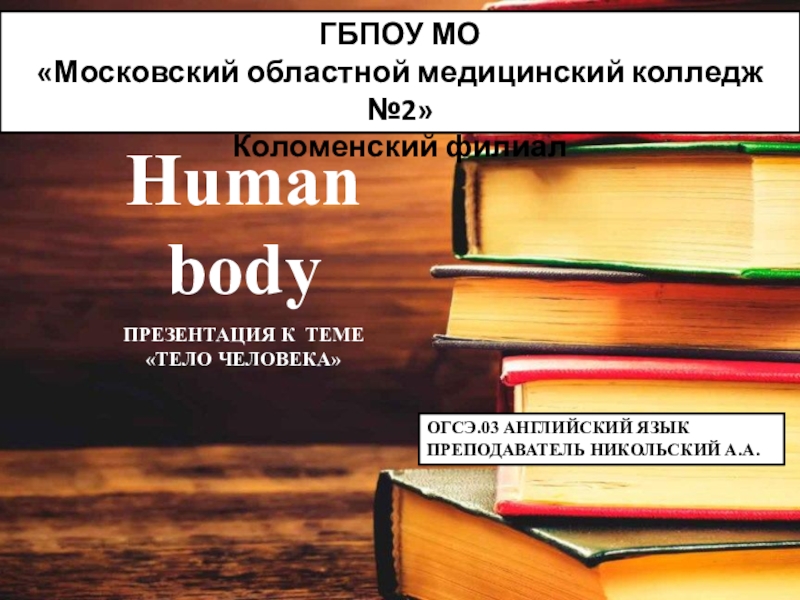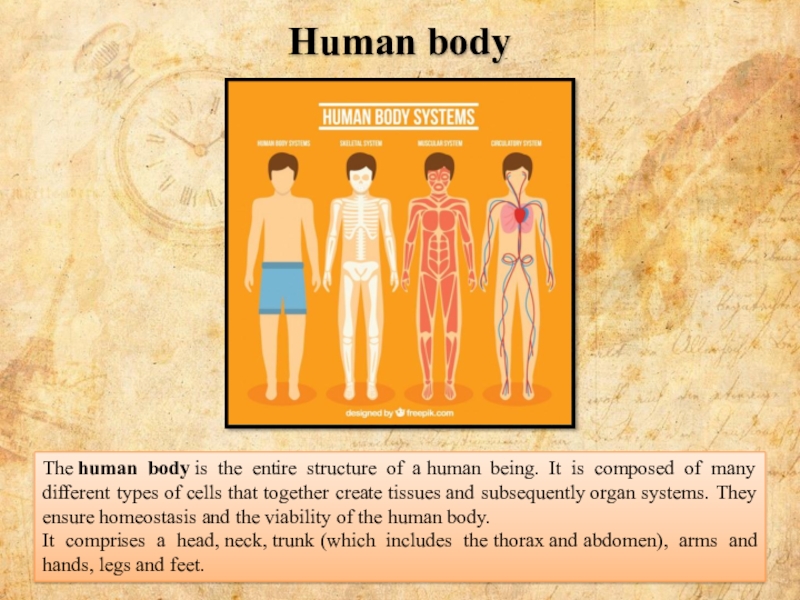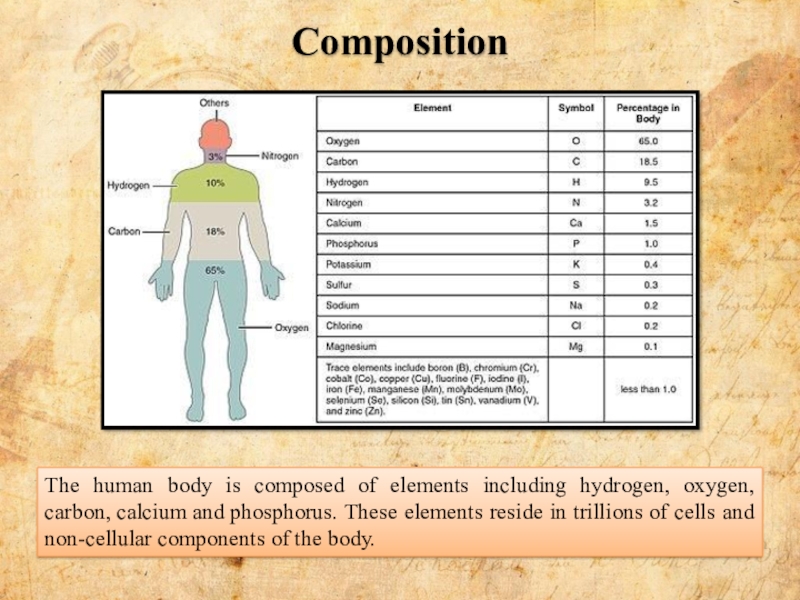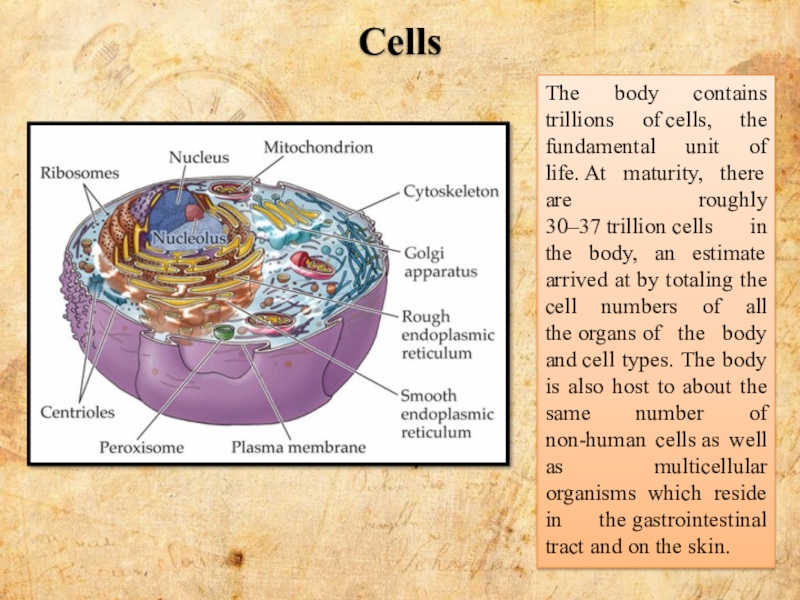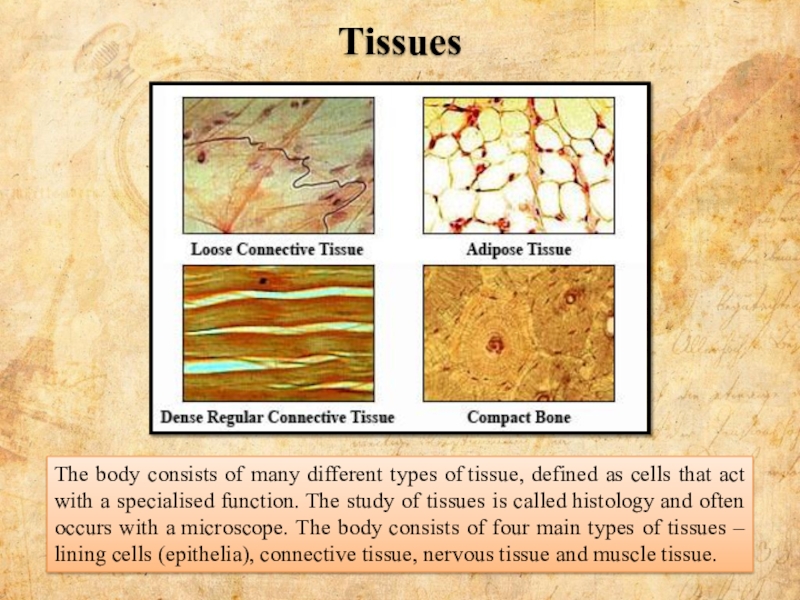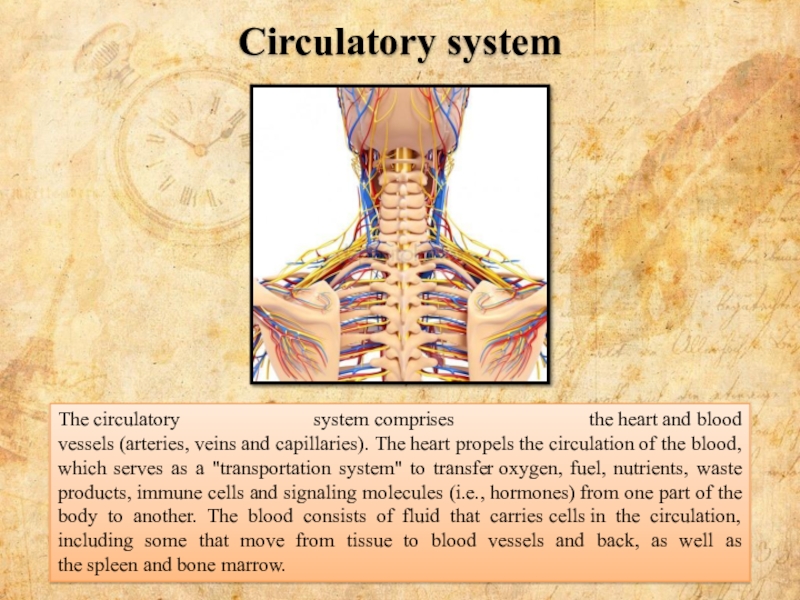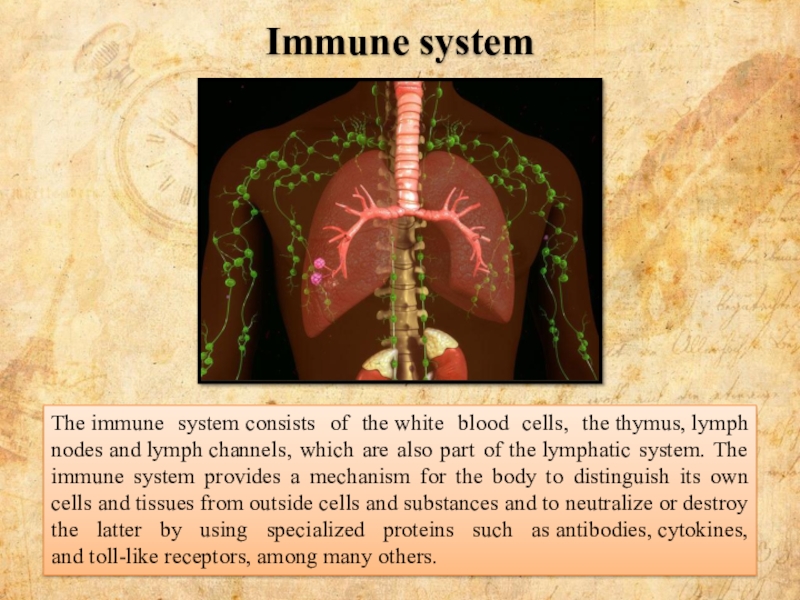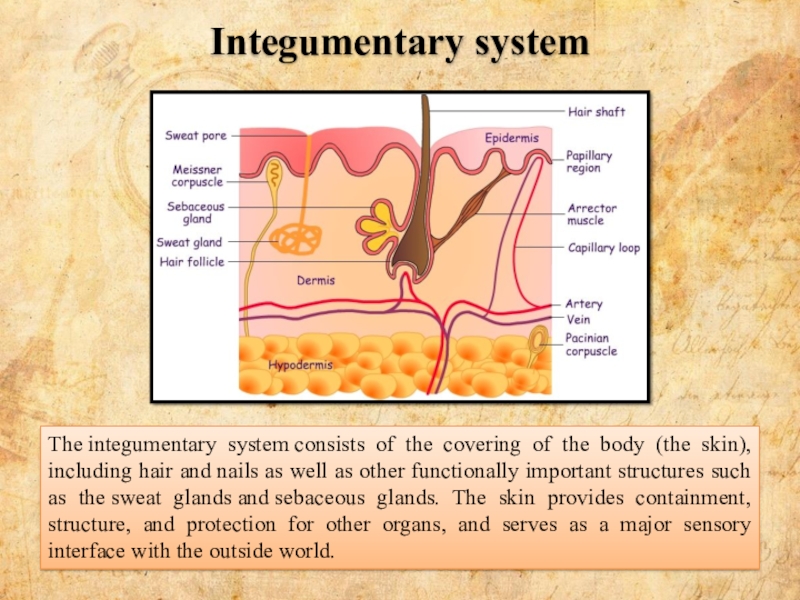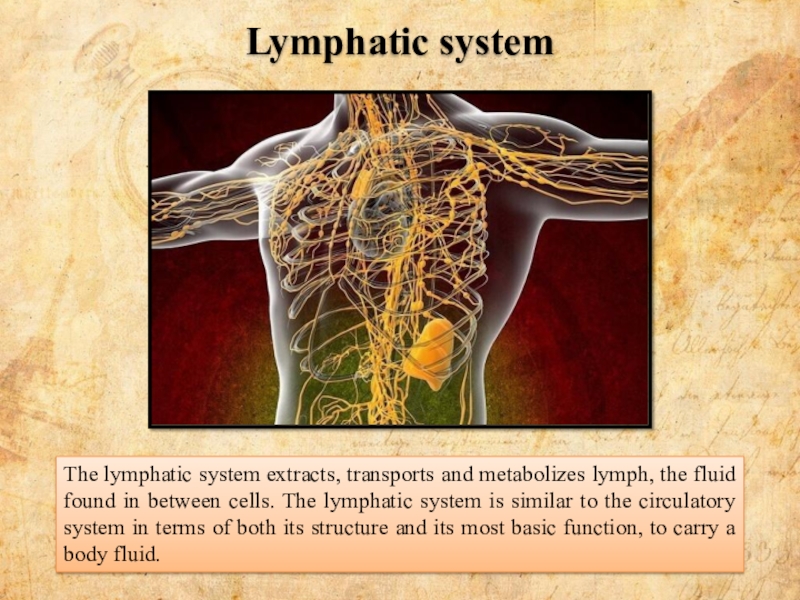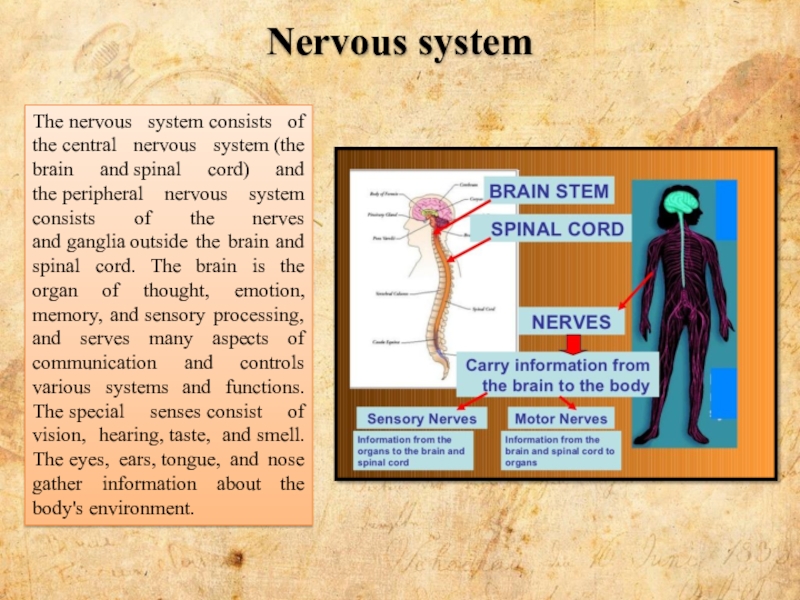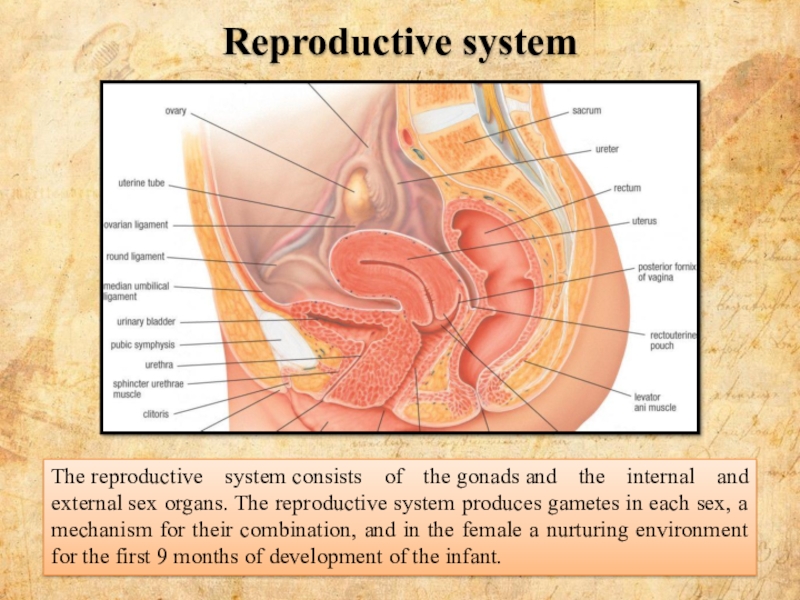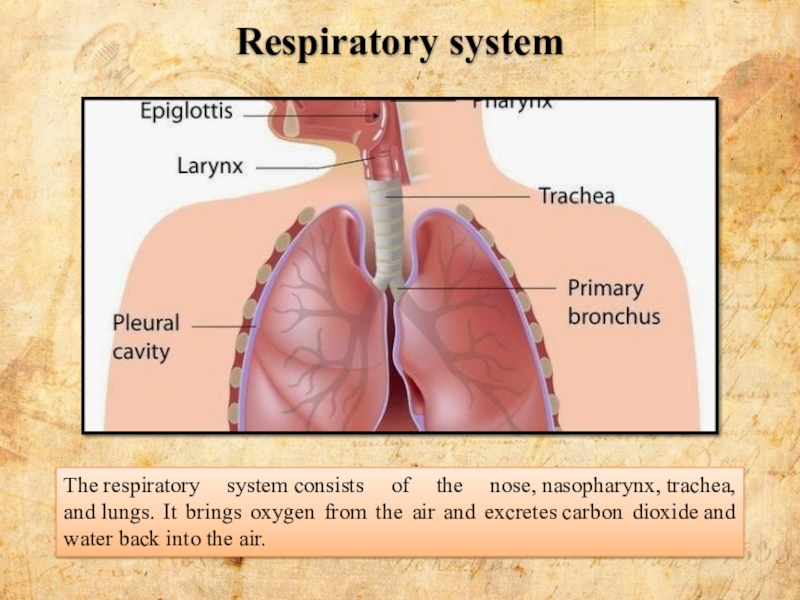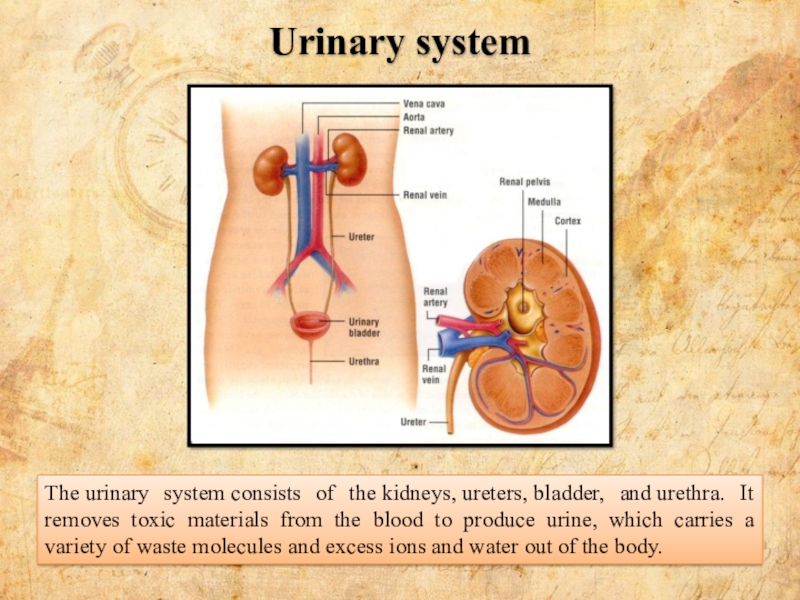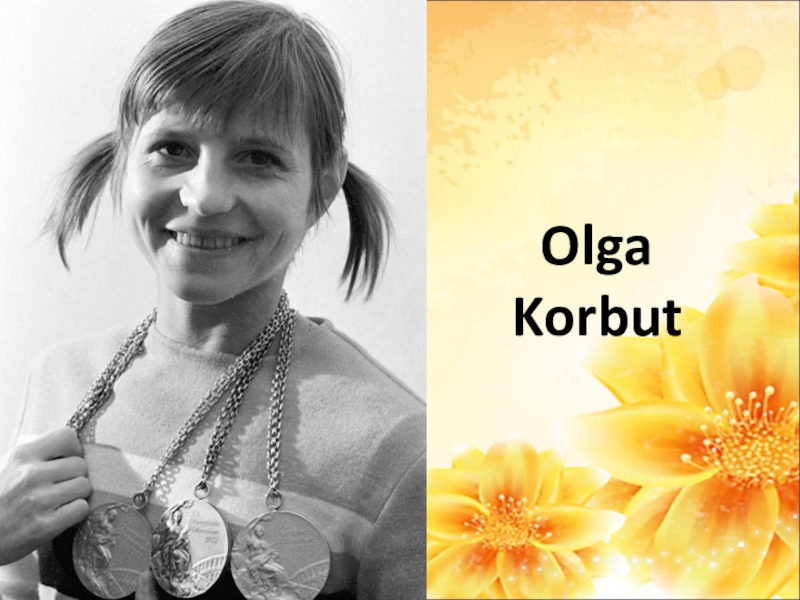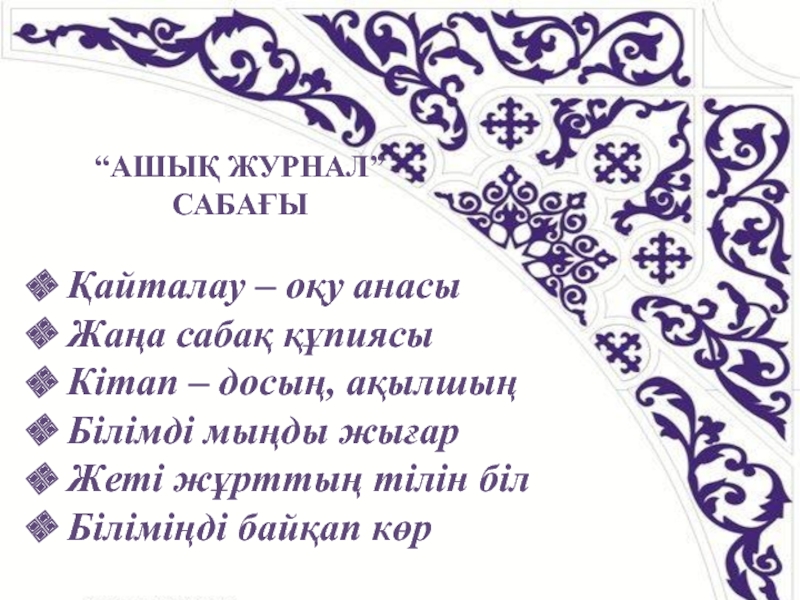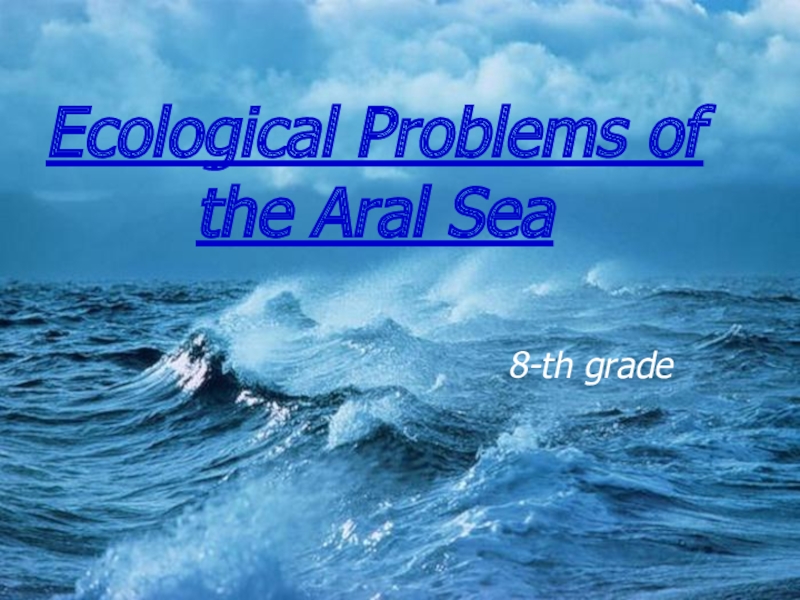ОГСЭ.03 АНГЛИЙСКИЙ ЯЗЫК
ПРЕПОДАВАТЕЛЬ НИКОЛЬСКИЙ А.А.
- Главная
- Разное
- Образование
- Спорт
- Естествознание
- Природоведение
- Религиоведение
- Французский язык
- Черчение
- Английский язык
- Астрономия
- Алгебра
- Биология
- География
- Геометрия
- Детские презентации
- Информатика
- История
- Литература
- Математика
- Музыка
- МХК
- Немецкий язык
- ОБЖ
- Обществознание
- Окружающий мир
- Педагогика
- Русский язык
- Технология
- Физика
- Философия
- Химия
- Шаблоны, фоны, картинки для презентаций
- Экология
- Экономика
Презентация, доклад на тему ОГСЭ.03 Английский язык Презентация по теме Тело человека
Содержание
- 1. ОГСЭ.03 Английский язык Презентация по теме Тело человека
- 2. Human bodyThe human body is the entire structure of
- 3. CompositionThe human body is composed of elements
- 4. CellsThe body contains trillions of cells, the fundamental
- 5. TissuesThe body consists of many different types
- 6. OrgansOrgans, structured collections of cells with a specific function, sit
- 7. Circulatory systemThe circulatory system comprises the heart and blood vessels (arteries, veins and capillaries). The heart
- 8. Digestive systemThe digestive system consists of the mouth
- 9. Endocrine systemThe endocrine system consists of the principal endocrine
- 10. Immune systemThe immune system consists of the white blood cells,
- 11. Integumentary systemThe integumentary system consists of the covering of
- 12. Lymphatic systemThe lymphatic system extracts, transports and metabolizes lymph,
- 13. Musculoskeletal systemThe musculoskeletal system consists of the human skeleton
- 14. Nervous systemThe nervous system consists of the central nervous system (the
- 15. Reproductive systemThe reproductive system consists of the gonads and the internal
- 16. Respiratory systemThe respiratory system consists of the nose, nasopharynx, trachea, and lungs.
- 17. Urinary systemThe urinary system consists of the kidneys, ureters, bladder, and urethra. It
- 18. BooksGanong's Review of Medical Physiology. 2016. ISBN 978-0-07-182510-8.Gray's anatomy:
Human bodyThe human body is the entire structure of a human being. It is composed of many different types of cells that together create tissues and subsequently organ systems. They ensure homeostasis and the viability of the human body.It comprises a head, neck, trunk (which includes the thorax and abdomen), arms and hands, legs and feet.
Слайд 1ГБПОУ МО
«Московский областной медицинский колледж №2»
Коломенский филиал
Human
body
ПРЕЗЕНТАЦИЯ К ТЕМЕ
«ТЕЛО
ЧЕЛОВЕКА»
Слайд 2Human body
The human body is the entire structure of a human being. It is
composed of many different types of cells that together create tissues and subsequently organ systems. They ensure homeostasis and the viability of the human body.
It comprises a head, neck, trunk (which includes the thorax and abdomen), arms and hands, legs and feet.
It comprises a head, neck, trunk (which includes the thorax and abdomen), arms and hands, legs and feet.
Слайд 3Composition
The human body is composed of elements including hydrogen, oxygen, carbon, calcium and phosphorus.
These elements reside in trillions of cells and non-cellular components of the body.
Слайд 4Cells
The body contains trillions of cells, the fundamental unit of life. At maturity,
there are roughly 30–37 trillion cells in the body, an estimate arrived at by totaling the cell numbers of all the organs of the body and cell types. The body is also host to about the same number of non-human cells as well as multicellular organisms which reside in the gastrointestinal tract and on the skin.
Слайд 5Tissues
The body consists of many different types of tissue, defined as cells
that act with a specialised function. The study of tissues is called histology and often occurs with a microscope. The body consists of four main types of tissues – lining cells (epithelia), connective tissue, nervous tissue and muscle tissue.
Слайд 6Organs
Organs, structured collections of cells with a specific function, sit within the body. Examples
include the heart, lungs and liver. Many organs reside within cavities within the body. These cavities include the abdomen and pleura.
Слайд 7Circulatory system
The circulatory system comprises the heart and blood vessels (arteries, veins and capillaries). The heart propels the circulation of
the blood, which serves as a "transportation system" to transfer oxygen, fuel, nutrients, waste products, immune cells and signaling molecules (i.e., hormones) from one part of the body to another. The blood consists of fluid that carries cells in the circulation, including some that move from tissue to blood vessels and back, as well as the spleen and bone marrow.
Слайд 8Digestive system
The digestive system consists of the mouth including the tongue and teeth, esophagus, stomach, (gastrointestinal
tract, small and large intestines, and rectum), as well as the liver, pancreas, gallbladder, and salivary glands. It converts food into small, nutritional, non-toxic molecules for distribution and absorption into the body.
Слайд 9Endocrine system
The endocrine system consists of the principal endocrine glands: the pituitary, thyroid, adrenals, pancreas, parathyroids, and gonads, but
nearly all organs and tissues produce specific endocrine hormones as well. The endocrine hormones serve as signals from one body system to another regarding an enormous array of conditions, and resulting in variety of changes of function.
Слайд 10Immune system
The immune system consists of the white blood cells, the thymus, lymph nodes and lymph channels, which are
also part of the lymphatic system. The immune system provides a mechanism for the body to distinguish its own cells and tissues from outside cells and substances and to neutralize or destroy the latter by using specialized proteins such as antibodies, cytokines, and toll-like receptors, among many others.
Слайд 11Integumentary system
The integumentary system consists of the covering of the body (the skin),
including hair and nails as well as other functionally important structures such as the sweat glands and sebaceous glands. The skin provides containment, structure, and protection for other organs, and serves as a major sensory interface with the outside world.
Слайд 12Lymphatic system
The lymphatic system extracts, transports and metabolizes lymph, the fluid found in
between cells. The lymphatic system is similar to the circulatory system in terms of both its structure and its most basic function, to carry a body fluid.
Слайд 13Musculoskeletal system
The musculoskeletal system consists of the human skeleton (which includes bones, ligaments,
tendons, and cartilage) and attached muscles. It gives the body basic structure and the ability for movement. In addition to their structural role, the larger bones in the body contain bone marrow, the site of production of blood cells. Also, all bones are major storage sites for calcium and phosphate. This system can be split up into the muscular system and the skeletal system.
Слайд 14Nervous system
The nervous system consists of the central nervous system (the brain and spinal cord) and
the peripheral nervous system consists of the nerves and ganglia outside the brain and spinal cord. The brain is the organ of thought, emotion, memory, and sensory processing, and serves many aspects of communication and controls various systems and functions. The special senses consist of vision, hearing, taste, and smell. The eyes, ears, tongue, and nose gather information about the body's environment.
Слайд 15Reproductive system
The reproductive system consists of the gonads and the internal and external sex organs. The
reproductive system produces gametes in each sex, a mechanism for their combination, and in the female a nurturing environment for the first 9 months of development of the infant.
Слайд 16Respiratory system
The respiratory system consists of the nose, nasopharynx, trachea, and lungs. It brings oxygen from
the air and excretes carbon dioxide and water back into the air.
Слайд 17Urinary system
The urinary system consists of the kidneys, ureters, bladder, and urethra. It removes toxic materials from
the blood to produce urine, which carries a variety of waste molecules and excess ions and water out of the body.
Слайд 18Books
Ganong's Review of Medical Physiology. 2016. ISBN 978-0-07-182510-8.
Gray's anatomy: the anatomical basis of
clinical practice. Editor-in-chief, Susan Standring (40th ed.). London: Churchill Livingstone. 2008. ISBN 978-0-8089-2371-8.
https://en.wikipedia.org/wiki/Human_body
2016. ISBN 978-0-07-182510-8. Ganong's Review of Medical Physiology.
https://en.wikipedia.org/wiki/Human_body
2016. ISBN 978-0-07-182510-8. Ganong's Review of Medical Physiology.
